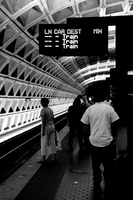Use industry standards for bus and rail on-time performance

Photo by Barbara.K on Flickr.
WMATA is proposing to lower its targets for on-time performance, because the old targets are arbitrary and they couldn’t meet them. How should they pick the right targets that are neither unrealistic nor overly conservative?
Monthly, WMATA reports the on-time performance for its buses or trains. Metro considers a bus “on-time” if it arrives at designated time points no more than 2 minutes early or 7 minutes late. We have criticized this in the past, because it can allow frequent buses to bunch while still counting those buses as “on time.”
On the rail side, Metro considers a peak period train “on time” if it deviates from schedule by no more than 2 minutes. During middays, evenings and weekends, trains are allowed to deviate from schedule by half of their headway; an train could therefore be 6 minutes off, or 10 minutes off when the trains aren’t as frequent, and still be considered “on time.”
In this month’s report, WMATA proposes reducing the goal for on-time performance from 95% of trains to 90% of trains, and from 80% to 78% for buses.
In response to numerous requests from board members at past meetings, WMATA staff addressed the idea of comparing their on-time performance against other other transit systems. They state in the presentation that comparing performance is not feasible because of differences in operating environments and the data that is reported. Staff also stated that the results can be easily misinterpreted. They concluded that benchmarking against their own performance was the only benchmarking needed.
WMATA could start addressing this incompatibility by standardizing the way it measures on-time performance with how other agencies do it.
The strictest on-time performance metric I could find was used by San Francisco’s Muni. They require all vehicles to arrive within one minute early and four minutes late, and by voter mandate are required to meet an 85% on-time performance goal (actual performance is in the mid-70s).
A performance criteria of less than one minute early and less than five minutes late is more typical. The 1 minute early to 5 minutes late or similar criterion is used in Seattle, San Mateo, Oakland, BART, Portland, and Connecticut. Except for CTA, of the transit systems I could find with published on-time performance criteria, Metro’s was the worst. Metro’s 2 minutes early, 7 minutes late criterion for buses allows more schedule deviation than other transit agencies.
CTA requires reporting rail delays of 10 minutes or greater, and reports raw numbers of incidents rather than percentages, making it impossible to compare CTA to WMATA. However, if Metro were required to report all delays of 10 minutes or greater, that would include a lot of the track fires, offloads and door problems that have become common on the rail system.
My recommendation would be for Metro to use the commonly reported goal for bus of 1 minute early to 5 minutes late, except for buses that are scheduled to arrive more frequently than every 12 minutes, where a headway (time between vehicles) maintenance goal of plus or minus two minutes should be set. As Jarrett Walker described, customers using frequent bus lines do not usually consult schedules, so if every bus on the line is exactly 10 minutes late, it looks the same. Regular spacing is what’s important to the customer, not strict schedule adherence.
For rail, Metro should keep the plus or minus two minute headway adherence during rush hours, but during off-peak, establish the same criteria as bus of no more than 1 minute early, and no more than five minutes late. The criteria should not become more generous when there are fewer trains operating.
When trains are operating infrequently, it is usually easier to adhere to schedule because the trains are less likely to interfere with each other. Additionally, infrequent trains make it more important to follow the schedule, since customers are more inconvenienced to miss a train when they come every 20 minutes instead of every 12.
This would establish the same on-time performance criteria for bus as it would for rail. The new criteria would be plus or minus two minutes on headways during rush hours, and one minute early to five minutes late outside of rush hours. At that point, Metro should see what the current performance looks like and set a goal accordingly.
I agree that the operating environment and traffic conditions are different here than in other cities, and the actual on-time performance will vary with conditions. But Metro should at least be informed by how other transit agencies measure and report the data, and adjust their metrics so some comparison can be made.
